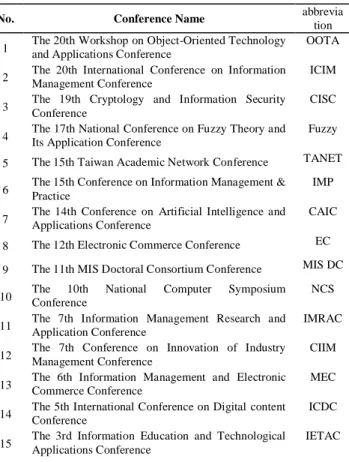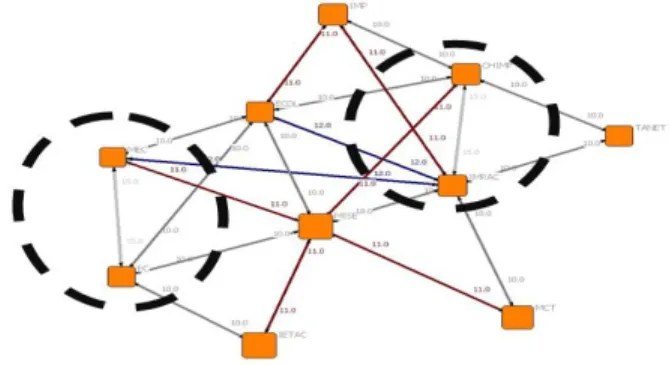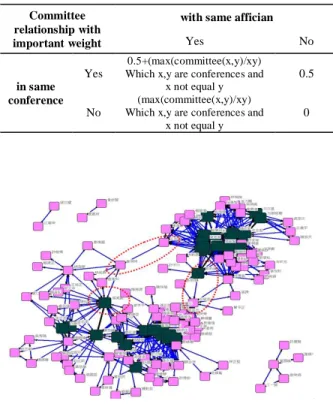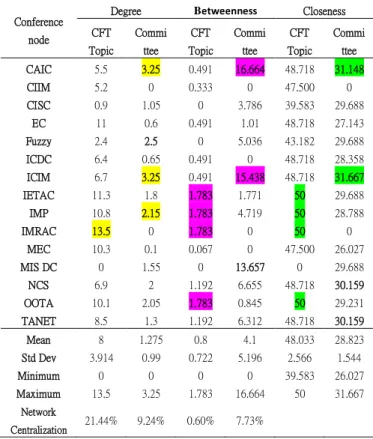Taiwan Academic Network Discussion via Social Networks Analysis Perspecitve
Chen-Shu Wang
Assistant Professor, Graduate Institute of Information and Logistics Management,
National Taipei University of Technology Hsinchu, Taiwan
e-mail:wangcs@ntut.edu.tw Yu-Chieh Li
Master, Dept. of Information Management, Chung Hua University
HsinChu, Taiwan e-mail: m09210029@chu.edu.tw
I-Hsien Ting
Assistant Professor, Dept. of Information Management, National University of Kaohsiung
Kaohsiung, Taiwan e-mail: iting@nuk.edu.tw
Abstract—Academic network (AN) is quite different network and hard to acquire relative information for inexperience researchers. To realize AN is an important but difficult work because of the constituents of AN are complicated and dynamic variation. In this research, two Taiwan academic networks are established from the perspectives of academic conference topic and participant committee. Each academic conference is regarded as an AN node to establish the conference academic network. In addition, there are two connection types between AN nodes, including: the relationship among CFP topics (academic conference topic perspective) and the relationship between committee member (participant committee perspective). Finally, 15 IT/IM relative target conferences in Taiwan 2009 are analyzed via social network analysis methodology. According to experiment result, the values of degree and betweeness reveal some interesting findings, such as TANET, OOTA and IMP are top three important bridge conferences in Taiwan. Additionally, as the cluster analyzed result shown, academic network somehow represents domain expertise because of the committee are grouped according to their research domains. These finding is consistence with the reality academic network in Taiwan and helpful information for Taiwan academic network understanding.
Keywords-academic social network network, Taiwan academic network, social network analyze,
I. INTRODUCTION
Academic Network (AN) is a specific kind of network that differ from others social networks. To realize AN is an important but difficult work because of the constituents of AN are complicated and dynamic variation. In general, AN may consist of scholars and researchers from various research domains. Additionally, a lot of academic activities, such as academic conference, workshop even forum are held regular that enables researchers to capture new research trend and exchange research idea (Matsuo, 2006). For inexperience researcher, to realized academic network is an important issue but hard work because of AN is a dynamic networks that the constituent members are around the work
and keeping dynamic variation. Therefore, a complete and systematical approach is necessary for research to realize and analyze academic network.
Basically, academic network is a kind of social network that consists of researchers and scholars. Thus, social networks analysis (SNA) is an appropriate methodology for AN analysis. SNA is an emerging methodology based on graph theory. In additional, SNA had been successfully applied to a lot of research domains. For illustration, Jin et al., (2009) had successful applied SNA result to rate business via raw data from search engine. They regarded business as network node and established a connection among businesses iff they appear in the same web page via search engine. Finally, the SNA analysis value (such as cooc, jaccard and overlap networks) can be regarded as business rank. In their experiment result, SNA result is consistent with practice survey result for business ranking. For another illustration, Crowe (2007) take society committee as node and discovery the development strategy by SNA methodology. SNA is a getting popular methodology and been widely applied to various domains because of the small world effect (Carrington, 2005) which every one can connect with each other via at most 6 people (6 degree) (Newman, 2006).
Particular, SNA is appropriate for networking (or graph) analysis (Carrington, 2005). Tomobe et al., (2003) had successfully established conference participant network of Japan scholar via SNA. However, various conference participants, including: scholars, students even software/hardware industries represent (or vendor), are too overarching and vague to find out academic network exactly. Thus, in this research, we establish academic network of conference committee members because of the conference committee amount is usually less than participant and more representation for specific academic network. Because of the conference committees are usually domain experts thus the committee social network can represent academic network appropriately. On the other hand, except for conference committee, academic conferences are also important
activities of academic network. A lot of academic conferences, for diversity of research issues, are held regular by various sponsors (such as university). However, there are almost no research to probe the relationship among conference relationship (such as CFP similarity or the committee networks) that provides information for inexperience researchers.
TABLE I. FIFTEEN ARGET CONFERENCE IN TAIWAN 2009
No. Conference Name abbrevia
tion 1 The 20th Workshop on Object-Oriented Technology and Applications Conference OOTA 2 The 20th International Conference on Information Management Conference ICIM 3 The 19th Cryptology and Information Security Conference CISC 4 The 17th National Conference on Fuzzy Theory and Its Application Conference Fuzzy 5 The 15th Taiwan Academic Network Conference TANET 6 The 15th Conference on Information Management &
Practice
IMP
7 The 14th Conference on Artificial Intelligence and Applications Conference CAIC 8 The 12th Electronic Commerce Conference EC 9 The 11th MIS Doctoral Consortium Conference MIS DC 10 The Conference 10th National Computer Symposium NCS 11 The 7th Information Management Research and Application Conference IMRAC 12 The 7th Conference on Innovation of Industry Management Conference CIIM 13 The 6th Information Management and Electronic Commerce Conference MEC 14 The 5th International Conference on Digital content Conference ICDC 15 The 3rd Information Education and Technological Applications Conference IETAC
However, the committee relationship or conference relationship is somehow existence. Therefore, SNA is employed to analyze Taiwan academic networks to reveal:
1) domain experts. In general, a search engine, such as google, is use to collect domain expert information. However, the accuracy of such searching result relies on webpage updating frequency and may be unrealizable. Thus, in this research, we reveal domain expert by SNA (cluster analysis) result of academic networks that consist of conference committee and conference CFP topics. As the cluster analysis result of SNA, the members belong to the same cluster can be regarded as they have similar expertise.
2) conferences relationships. SNA can find a specific conference via SNA result from the perspectives of committee relationship and CFP topics. Such result is useful for inexperience researcher.
Thus, in the research, the Taiwan academic network (TAN) of information management (IM) relative is established via academic conference network analysis. Finally, 15 academic conferences held in Taiwan 2009 are regarded as target conferences listed is Table 1. At first, the committee information and CFP topics of target conferences are collected. Then, two academic networks (from committee network and conference network perspective) are established via different aspects. Finally, the academic network is analyzed by free SNA software, UCINET 6.0. The research goals including:
a) to realize IT- (information technology) and IM- (Information management) relative academic network in Taiwan.
b) to discovery the domain expertise via SNA result of committee network.
c) enables IT/IM academic member to understand new research trend via SNA result of conference network.
II. TAIWAN ACADEMIC NETWORK OF IT/IMDOMAIN To realize IT (information technology) and IM (Information management) relative academic network in Taiwan. 15 target conferences in Table 1 are adopted to establish the academic network. Among these 15 target conferences, there are 807 different committees and 92 distinct CFP topics. These parameters are further established two academic networks and analyzed.
A. Academic Network analyze from Conference Aspect
At first, 15 target conferences are analyzed from conference perspective. In other words, each conference is regarded as network node. There are two connection types including: committee member relationship and CFP topic relationship among node. In Model 1 (Conference relationship perspective), each node is regarded as AN node. If conference x and y have the same committee member c (c=committee(x,y) > 0 that return the amount of committee member who participant conference x and y) and then a link is established between conference x and y with weight ( the weight value is committee(x,y)/ total committee member
amount). Additionally, from CFP topic perspective, if
conference x and y have the same conference topic
(t=topic(x,y) > 0 that return the amount of CFP topic that
appear in conference x and y) and a link is established between x and y with weight(the weight value is topic(x,y)/
Figure 1. Taiwan IT/IM Conference Network from conference node aspect.
Furthermore, these two networks are analyzed via SNA methodology. As the analyzed result show in Fig. 1, the green nodes (represented conference) in group 1 are all information technology (IT) relative conference, such as fuzzy, CAIC and OOTA conferences as listed in Table 1. Particular, the relationship important weight between fuzzy and CAIC conference is 1.3 that represents a lots of committees members are participant these two conferences. On the others hands, a purple nodes in group 2 are almost information management (IM) relative conference, such as ICIM, IMP and MISDC conferences. Additionally, a lot of conference committees of IMP and MISDC conferences are participant ICIM conference at the same time. Particular the important weight of relationship between IMP and ICIM conference is 1 that represents the at least 10% committee members of these two conferences are the same. All conferences listed in these two groups are academic significant conferences in Taiwan and hold over 20 years, such as ICIM had hold 21 years and OOTA even over 20 years.
Figure 2. Taiwan IT/IM Conference Network from CFP topics Analyze (I) For the other perspective, the conference connection is evaluated via co-relation of the topic listed in conference CFP. In other words, the connection between nodes (conference) is established iff two conferences have the same
CFP topic and the important weight can be evaluate the similarity between two conference nodes. Then, such network is analyzed via SNA and the academic network topology is shown in Fig. 2. From CFP topic perspective, an interesting pattern is found that two isolated conferences appeared MISDC and CISC conferences. As the analyzed result shown, MIS DC is an open issue conference that all Ph. D. student who can submit their completed or under-work thesis for conference publication. Hence, for such conference, no obvious connection can be established with others. For another isolated conference, CISC is a specific domain conference that relative to information security thus no connection can be established to others conference.
Figure 3. Taiwan IT/IM Conference Network from CFP topics Analyze (II).
In these 15 target conference, there are over 90 topics listed in 15 CFPs. Thus, only the conference with important weight over 1 will be discussed further. The important weight of conference represents connected degree. As the important weight above 1 that represents 10% CFP topics are similar in the group. Finally, two groups are emergence in Fig. 3 and analyzed further. The first group is medical-relative conferences, including: CHIMP, IMRAC, and the common issues between these conferences are above 10%. The second group is electronic commence relative conferences, including: IMRAC and MEC and the important weight is 1.2 that represents 12% CFP topics among these three conferences are the same. As the social network analyze result show, electronic commerce and its applications remain an important and hot research trend. On the other hand, various IT applications of medical domain are emergence research topics and such research trend is a tight group. We can inferred that because of the cloud computing emergence and e-healthy care important increasing, IT & Medical information can become next research trend, such as the combination and application of Decision-making Support and Expert systems, Knowledge Management of medical relative research can be worth to devote research issue.
Finally, an interesting pattern is also emergence that IT-relative conferences are tight connected (above) than IM-relative conference. Additionally, some bridge conferences are appeared via SNA, including TANET, OOTA and IMP conferences. Particular, OOTA and IMP are important
bridge conferences that bridge IT and management conference from conference CFP perspective.
Figure 4. Taiwan IT/IM Conference Network from CFP topics Analyze (III).
B. Academic Network analyze from Conference Committee Aspect
In this session, an academic network for Taiwan IT/IM 15 target conference is established through conference committees. Thus, totally 807 conference committees (of 15 selected target conferences in 2009) are regarded as conference node and the relationship important weight is shown as Table 2.
TABLE II. TABLE TYPE STYLES
Committee relationship with important weight
with same affician
Yes No
in same conference
Yes
0.5+(max(committee(x,y)/xy) Which x,y are conferences and
x not equal y
0.5
No
(max(committee(x,y)/xy) Which x,y are conferences and
x not equal y
0
Figure 5. Taiwan IT/IM Conference Network from conference node aspect.
III. EXPERIMENT RESULT AND CONCLUSION In this research, two academic networks are established from conference and committee member aspects separately. Furthermore, 15 IT/IM relative conferences in Taiwan 2009 are regarded as target conferences and analyze via social network methodology. As the experiment results demonstrate from Fig. 1 to Fig. 6, the proposed assumptions are all supported. The SNA is appropriate for academic network analyze. As Fig. 6 shown, the conference committees network can be represented their expertise and research domain. For illustration, some e-learning related experts are clustered and in the same group. Additionally, some important structure holes are also discovered from academic networks (conference network and committee network) via SNA. For illustration, as Fig. 4 and Fig. 5 shown, some important conference and committee members are found. These information is hard to collect but useful for inexperience researchers.
Figure 6. Taiwan IT/IM Conference Network from conference node aspect: two tihgt group
Furthermore, for both academic networks, some SNA indicator are detailed in Table 3, including: degree, between and closeness values. For conference academic network, the highest degree is 13.5 On the other hand, for the committee member academic network, both ICIM and CIA conferences are with the highest degree value that represents most committee participants the same conference. For the between value, some important bridge conference can be found. For the research topics in CFP analysis result show, IETAC, IMP, IMRAC, MISE and OOTA are the most important bridge conferences. These conferences are all with the highest between values that represent the closest conference to other conference from research issue perspectives. The top three conferences are CAIC, ICIM and MISDC conference that represent important bridge conferences.
To realize and collection information of academic network is an important but hard work for inexperience researcher. The proposed SNA model and methodology is validated appropriate and efficiency for academic network established and analyzed. Further, more conferences can be added for completed academic network construct.
Additionally, regular conference information can be also extended to understand the academic network change and trend.
TABLE III. FIFTEEN IT/IM RELATIVE ACADEMIC NETWORK ANALYZE VIA SNA
REFERENCES
[1] Yingzi Jin, Yutaka Matsuo, and Mitsuru Ishizuka: Extracting Inter-Firm Networks from World Wide Web Using General-Purpose Search Engine, Journal of Online Information Review, Vol 32, no. 2, 2008
[2] Jessica Crowe, In search of a happy medium: How the structure of interorganizational networks influence community economic development strategies, Social Networks, Vol. 29, Issue 4, October 2007, Pages 469-488
[3] Hironori Tomobe, Yutaka Matsuo, Koiti Hasida, Mitsuru Ishizuka, Social Network Extraction of Conference Participants,http://ymatsuo.com/papers/www2003.pdf
[4] Yutaka Matsuo, J. Mori, K. Ishida, M. Hamasaki, H. Takeda, T. Nishimura, K. Hasida and M. Ishizuka, POLYPHONET: An advanced social network extraction system from the Web,Web Semantics: Science, Services and Agents on the World Wide Web 5 (2007) 262–278
[5] Peter J. Carrington, John Scott, Stanley Wasserman, Models and Methods in Social Network Analysis, Cambridge University Press , First Published 2005.
[6] Newman, Mark, Albert-László Barabási, and Duncan J. Watts. 2006. The Structure and Dynamics of Networks. Princeton, NJ: Princeton University Press.
[7] Bizot, E., Smith, N., & Hill, T. (1991). Use of electronic mail in a research and development organization. In J. Morell & M. Fleischer (Eds.), Advances in the implementation and impact of computer systems (pp. 65-92). Greenwich, CT: JAI.
Conference node
Degree Betweenness Closeness CFT Topic Commi ttee CFT Topic Commi ttee CFT Topic Commi ttee CAIC 5.5 3.25 0.491 16.664 48.718 31.148 CIIM 5.2 0 0.333 0 47.500 0 CISC 0.9 1.05 0 3.786 39.583 29.688 EC 11 0.6 0.491 1.01 48.718 27.143 Fuzzy 2.4 2.5 0 5.036 43.182 29.688 ICDC 6.4 0.65 0.491 0 48.718 28.358 ICIM 6.7 3.25 0.491 15.438 48.718 31.667 IETAC 11.3 1.8 1.783 1.771 50 29.688 IMP 10.8 2.15 1.783 4.719 50 28.788 IMRAC 13.5 0 1.783 0 50 0 MEC 10.3 0.1 0.067 0 47.500 26.027 MIS DC 0 1.55 0 13.657 0 29.688 NCS 6.9 2 1.192 6.655 48.718 30.159 OOTA 10.1 2.05 1.783 0.845 50 29.231 TANET 8.5 1.3 1.192 6.312 48.718 30.159 Mean 8 1.275 0.8 4.1 48.033 28.823 Std Dev 3.914 0.99 0.722 5.196 2.566 1.544 Minimum 0 0 0 0 39.583 26.027 Maximum 13.5 3.25 1.783 16.664 50 31.667 Network Centralization 21.44% 9.24% 0.60% 7.73%



